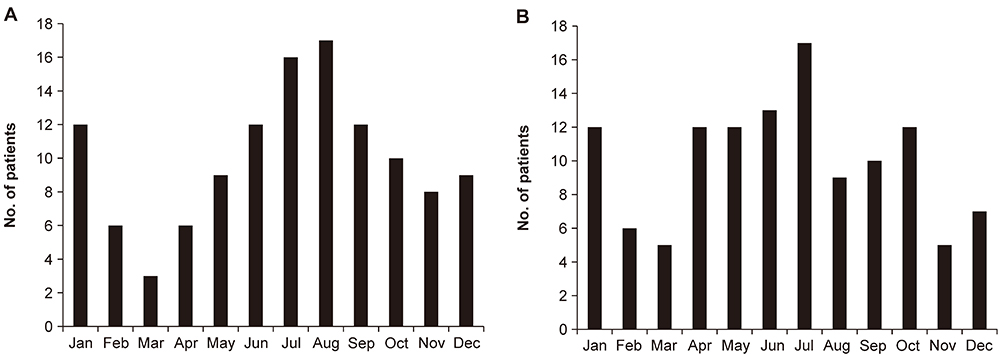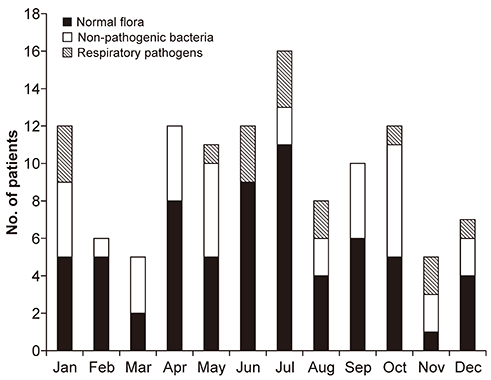Obstet Gynecol Sci.
2016 Mar;59(2):130-136. 10.5468/ogs.2016.59.2.130.
Clinical and microbiologic characteristics of vulvovaginitis in Korean prepubertal girls, 2009-2014: a single center experience
- Affiliations
-
- 1Department of Obstetrics and Gynecology, CHA Bundang Medical Center, CHA University, Seongnam, Korea. yeegen@cha.ac.kr
- KMID: 2159008
- DOI: http://doi.org/10.5468/ogs.2016.59.2.130
Abstract
OBJECTIVE
To update information on the clinical and microbiologic characteristics of pediatric vulvovaginitis in Korean prepubertal girls.
METHODS
A total of 120 girls (aged 0 to 9 years) with culture-confirmed pediatric vulvovaginitis, diagnosed between 2009 and 2014, were enrolled in the study. The epidemiologic and microbiologic characteristics, and clinical outcomes were assessed. Patients with sexual precocity, as well as those who were referred for suspected sexual abuse, were excluded.
RESULTS
Girls aged 4 to 6 years were at the highest risk of pediatric vulvovaginitis. Seasonal distribution indicated obvious peaks in summer and winter. Of the 120 subjects, specific pathogens were identified in the genital specimens in only 20 cases (16.7%). Streptococcus pyogenes (n=12, 60%) was the leading cause of specific vulvovaginitis. Haemophilus influenzae was isolated in one patient. No cases presented with enteric pathogens, such as Shigella or Yersinia. A history of recent upper respiratory tract infection, swimming, and bubble bath use was reported in 37.5%, 15.8%, and 10.0% of patients, respectively. Recent upper respiratory tract infection was not significantly correlated with the detection of respiratory pathogens in genital specimens (P>0.05). Of 104 patients who underwent perineal hygienic care, 80 (76.9%) showed improvement of symptoms without antibiotic treatment. Furthermore, the efficacy of hygienic care was not significantly different between patients with or without specific pathogens (P>0.05).
CONCLUSION
Specific pathogens were only found in 16.7% of pediatric vulvovaginitis cases. Our results indicate an excellent outcome with hygienic care, irrespective of the presence of specific pathogens.
Keyword
MeSH Terms
Figure
Reference
-
1. Paradise JE, Campos JM, Friedman HM, Frishmuth G. Vulvovaginitis in premenarcheal girls: clinical features and diagnostic evaluation. Pediatrics. 1982; 70:193–198.2. Pierce AM, Hart CA. Vulvovaginitis: causes and management. Arch Dis Child. 1992; 67:509–512.3. Cuadros J, Mazon A, Martinez R, Gonzalez P, Gil-Setas A, Flores U, et al. The aetiology of paediatric inflammatory vulvovaginitis. Eur J Pediatr. 2004; 163:105–107.4. Joishy M, Ashtekar CS, Jain A, Gonsalves R. Do we need to treat vulvovaginitis in prepubertal girls? BMJ. 2005; 330:186–188.5. Cox RA. Haemophilus influenzae: an underrated cause of vulvovaginitis in young girls. J Clin Pathol. 1997; 50:765–768.6. Kim HC, Lee MH, Hong SG. Pediatric vulvovaginitis: a study of clinical and microbiologic features and the efficacy of perineal hygienic care. Korean J Obstet Gynecol. 1999; 42:2821–2828.7. Stricker T, Navratil F, Sennhauser FH. Vulvovaginitis in prepubertal girls. Arch Dis Child. 2003; 88:324–326.8. Yilmaz AE, Celik N, Soylu G, Donmez A, Yuksel C. Comparison of clinical and microbiological features of vulvovaginitis in prepubertal and pubertal girls. J Formos Med Assoc. 2012; 111:392–396.9. Hammerschlag MR, Alpert S, Rosner I, Thurston P, Semine D, McComb D, et al. Microbiology of the vagina in children: normal and potentially pathogenic organisms. Pediatrics. 1978; 62:57–62.10. Gerstner GJ, Grunberger W, Boschitsch E, Rotter M. Vaginal organisms in prepubertal children with and without vulvovaginitis: a vaginoscopic study. Arch Gynecol. 1982; 231:247–252.11. Jaquiery A, Stylianopoulos A, Hogg G, Grover S. Vulvovaginitis: clinical features, aetiology, and microbiology of the genital tract. Arch Dis Child. 1999; 81:64–67.12. Emans SJ. Vulvovaginal problems in the prepubertal child. In : Emans SJ, Laufer MR, editors. Pediatric and adolescent gynecology. 6th ed. Philadelphia (PA): Lippincott Williams & Wilkins;2012. p. 42–59.13. Lang WR. Pediatric vaginitis. N Engl J Med. 1955; 253:1153–1160.14. Shapiro RA, Schubert CJ, Siegel RM. Neisseria gonorrhea infections in girls younger than 12 years of age evaluated for vaginitis. Pediatrics. 1999; 104:e72.15. McGreal S, Wood P. Recurrent vaginal discharge in children. J Pediatr Adolesc Gynecol. 2013; 26:205–208.16. Hansen MT, Sanchez VT, Eyster K, Hansen KA. Streptococcus pyogenes pharyngeal colonization resulting in recurrent, prepubertal vulvovaginitis. J Pediatr Adolesc Gynecol. 2007; 20:315–317.17. Mogielnicki NP, Schwartzman JD, Elliott JA. Perineal group A streptococcal disease in a pediatric practice. Pediatrics. 2000; 106(2 Pt 1):276–281.18. Straumanis JP, Bocchini JA Jr. Group A beta-hemolytic streptococcal vulvovaginitis in prepubertal girls: a case report and review of the past twenty years. Pediatr Infect Dis J. 1990; 9:845–848.19. Sharma B, Preston J, Greenwood P. Management of vulvovaginitis and vaginal discharge in prepubertal girls. Rev Gynaecol Pract. 2004; 4:111–120.20. Dei M, Di Maggio F, Di Paolo G, Bruni V. Vulvovaginitis in childhood. Best Pract Res Clin Obstet Gynaecol. 2010; 24:129–137.
- Full Text Links
- Actions
-
Cited
- CITED
-
- Close
- Share
- Similar articles
-
- Childhood Candidal Vulvovaginitis
- Canadida Vulvovaginitis
- Differences of Clinical Characteristics and Phenotypes between Prepubertal- and Adolescent-Onset Bipolar Disorders
- Pediatric Vulvovaginitis: A Study of Clinical and Microbiologic features and the Efficacy of Perineal Hygienic Care
- Two Cases of Childhood Candidal Vulvovaginitis Due to Sexual Abuse




